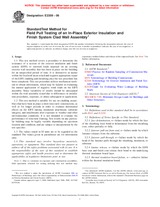Potřebujeme váš souhlas k využití jednotlivých dat, aby se vám mimo jiné mohly ukazovat informace týkající se vašich zájmů. Souhlas udělíte kliknutím na tlačítko „OK“.
ASTM E2359-06
Standard Test Method for Field Pull Testing of an In-Place Exterior Insulation and Finish System Clad Wall Assembly
Automaticky přeložený název:
Standardní zkušební metoda pro Field Vytáhněte testování In- Place Vnější izolace a úprava systému Clad Wall shromáždění
NORMA vydána dne 1.4.2006
Informace o normě:
Označení normy: ASTM E2359-06
Poznámka: NEPLATNÁ
Datum vydání normy: 1.4.2006
Kód zboží: NS-45125
Počet stran: 7
Přibližná hmotnost: 21 g (0.05 liber)
Země: Americká technická norma
Kategorie: Technické normy ASTM
Anotace textu normy ASTM E2359-06 :
Keywords:
design wind pressure, design wind loads, DWP, EIFS, Exterior insulation and finish system, face delamination, moisture deterioration, negative pressure, pull test, pull test frame, stud spacing, substrate integrity, ICS Number Code 91.120.30 (Waterproofing)
Doplňující informace
| Significance and Use | ||||||||||
|
The purpose of this test method is to assess the installation adequacy and the overall effects of service-related deterioration (moisture, etc.) on the EIFS wall assembly as opposed to small localized areas of degradation. Resistance to pull testing as determined by this test is used as one of the factors in evaluating the EIFS assembly on a specific project. The values obtained by this test method are not purported to be representative of the actual wind load capacity or other structural properties of a specific EIFS clad wall installation, but may be helpful in assessing such load capacities. Since this test is used for field evaluation of existing facilities, load results obtained from this test must be interpreted based on sound engineering practice, applicable building regulations, and codes having jurisdiction. It is the discretion of the test specifier to directly utilize the results derived by this test method, or else to utilize the test results with an appropriate factor of safety to obtain acceptable working loads for each project. This method is intended for use on test specimens occurring or installed on existing buildings. The loss of outward wind load resistance of an EIFS wall assembly after exposure to moisture and other weather conditions may compromise the ability of the cladding or other wall components to perform adequately in place. This test method does not provide any means by which the test results may be generalized to the larger wall area. Such efforts should be based on experience and engineering judgement. The manner in which the test load is applied may affect the load capacity obtained from using this standard. A discussion of various load application techniques and their effects is given in Appendix X1. |
||||||||||
| 1. Scope | ||||||||||
|
1.1 This test method covers a procedure to determine the resistance of a section of the exterior insulation and finish system (EIFS) to outward loads imposed on an existing exterior wall assembly that has been in place on the building for an unspecified period of time. It is destructive in nature within the localized areas tested and requires appropriate repair of the EIFS cladding and sheathing once the test procedure has been completed. This test procedure utilizes mechanical methods to obtain information, which may be helpful in evaluating the natural application of negative wind loads on the EIFS assembly. Some variability of results should be anticipated within the wall assembly tested due to differences in installation procedures, exposure, or abuse subsequent to application. 1.2 This test method is suitable for use on cladding assemblies that have been in place a short time (new construction), as well as for longer periods in order to evaluate detrimental effects on the EIFS lamina, insulation attachment, substrate integrity, and attachments after exposure to weather and other environmental conditions. It is not intended to evaluate the performance of structural framing. Test results on any particular building may be highly variable depending on specimen location and condition, and are subject to interpretation by the test specifier. 1.3 The values stated in SI units are to be regarded as the standard. The values given in parentheses are for information only. This standard may involve hazardous materials, operations, or equipment. This standard does not purport to address all of the safety problems associated with its use. It is the responsibility of the user of this standard to establish appropriate safety and health practices and to determine the applicability of regulatory limitations prior to use. Note 1Due to variations in exposure and construction assemblies, field specimens selected for testing utilizing this test method may experience sudden failure and release of the imposed loads. See Note 7 for further information. |
||||||||||
| 2. Referenced Documents | ||||||||||
|
Odebírejte informace o nově vydaných normách ZDARMA:
Chcete pravidelně odebírat informace o nově vycházejících normách z celého světa a to zcela zdarma?
Přihlašte se k odběru. Vše je velice jednoduché a absolutně ZDARMA.
Na výběr máte vydavatele z celého světa.




 Cookies
Cookies
